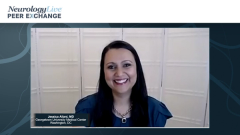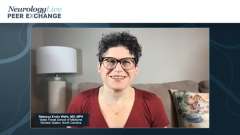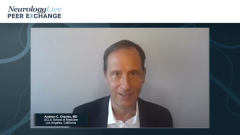
Discussing Novel Agents for Preventative Migraine Therapy with Patients
A thought leader explains how she involves the patient when selecting novel agents to add to a preventive migraine treatment plan.
Episodes in this series

Jessica Ailani, MD: Speaking of when we’re taking these treatments to the patient, Rebecca, bringing it back to you, how do we take this and discuss it with a patient? When you’re taking a new treatment vs the older treatments? What does that conversation sound like?
Rebecca Erwin Wells, MD, MPH: That’s just so important and I highlight a lot of what Andy said.When patients are interested in preventive treatment options, I say, “We have pharmacological and we have nonpharmacological [treatments] and sometimes it’s important to try both.” Then when we’re talking about pharmacological options I say, “You know, we have a long history of treating migraine. People have had migraines for so long and we have a lot of older options that were developed for other indications but many have FDA approval for migraine.Those can be excellent options and sometimes in addition to migraine may target other comorbidities in terms of sleep, or insomnia, or weight, and obesity, depression, anxiety. So those can be helpful. Then I say, ‘But we’re in a really exciting time where we have new medications that were specifically designed to target the pathophysiology of migraine.”
In the past, we were borrowing medications from other classes of drugs but now we have medications specifically designed and created for migraine. It’s a fun time to be treating migraine because we have all these new available options. I explain that enthusiasm to patients like, “It is so wonderful that we have all these options available and you are at a great time to come to me to seek care because we have so many more options available to target what is impacting your life.”
Jessica Ailani, MD: If I were your patient I’d be excited because you sound so excited about treatment. Do you use that enthusiasm to convince them to start prevention like when they come to see you if they have disability? Do you talk to them about being hesitant because people often are about taking something every day? How do you really loop that fear into well, ‘let’s get you feeling better?’
Rebecca Erwin Wells, MD, MPH: Yeah, that’s a great question. One of the most valuable questions I have found in asking patients is, “What are the goals of your care?” Of course, I’m always surprised by the number of patients who will say, “I want to cure my migraine.” I will then sometimes explain that that’s not the goal of our care. Our goal is to decrease the frequency and have a plan of action when they do happen.
By asking that question, “What are the goals of your care,” I can understand what is most important to them. Whether it’s being able to function when they have that attack, or decrease the frequency of their attacks, or being able to participate in their children’s lives in a more meaningful way. I dig out what it is that’s driving them to want to improve their lives.
Then I walk them through the different options because some patients will be very clear and say, “I am not interested in an injection.” Like, you know, that is not something I want. And then other patients will say, “I don’t want to take a medicine every single day like that. I can’t keep up with that.” Walking the patient through the different options, what they entail, and what side effects or what comorbidities can be treated, I think is really, really helpful in their understanding so that we’re really experiencing a sort of shared decision and then patients feel like they’re involved in making the decision.
One of the tools that I learned from one of my mentors was sometimes doing nothing is OK too. Just providing the options and the opportunities in what’s available and letting patients think about it and say, “So we’ve discussed a lot today. I’m going to give you some more information that you can read about these options. Why don’t we schedule a fuller visit and then we can talk about it more.” Because it’s I think one of the key aspects of being able to treat patients while developing a therapeutic alliance.
The last thing we want to do is try to pretend that we know what the patient really wants, or assume that we know which treatment option is best when really the patient themselves can tell us what they’re most interested in. What we can do is provide all of the options available so that they can recognize what they may want to try.
Jessica Ailani, MD: Your mentor inspired an article by Atul Gawande, who is one of my favorite writers, who of course then inspired me to follow suit with a similar idea which is to provide the options to the patient but recognize very quickly when the patient is uncomfortable and not yet ready to make a decision. Because regret is the number one factor in dissatisfaction. The patient could actually end up cured of migraine, which is never really a goal, and not really something that happens often but every once in a while can stumble upon it by mistake. But the patient can still be unhappy and dissatisfied because they were not yet ready for that decision or really ready for that option.
It is very important that if you sense the patient is not yet ready to make a decision, you send them home with options and make a very quick follow-up. “In 2 weeks, let’s have a telehealth visit,” which is so wonderful to have this option now, or “Let’s schedule you to come back in. You have these tools, talk to all the people.” I encourage patients, to “Go on the internet. Go at it,” because they’re going to do it anyway. Come back with your list of the top 10 most absurd things you heard about these drugs, and I will come back at you with everything that is real and not real and all the gaps in between because when you make the choice, you should feel comfortable with it. So, yes, she is a wonderful mentor. Stephanie, you had some comments you wanted to make.
Stephanie J. Nahas, MD, MSEd, FAHS, FAAN: I would echo all of this. I mean, it’s resonating so much with what I see in my practice, too, has to be individualized, and has to have buy-in to build that alliance. What I’ll say for anybody who’s not yet bought into this concept and think it takes too much time; it doesn’t really take all that much time and it saves you so much time later on. Another important aspect. When we do this, we are often kind of struck when the patient says, “Nobody has ever outlined that many options for me before and given me a choice. My other doctors just told me what to do. It’s like do this or go elsewhere.” So they really appreciate that. When it comes to the newer agents, there are a few other things to consider. I’ve had some patients who don’t want to take something new because it’s new and they’re afraid.
I have one patient in particular who I still cannot convince to try onabotulinumtoxinA, and it took 3 years to convince her to try a monoclonal antibody but now she’s doing it and she’s getting better. She’s not great but she’s getting better, and she was very thankful that we were persistent in continuing to ask, “Are you ready, are you ready?” Because she would shoot us down visit after visit, “No, I’m not ready.” So they have to be ready and you have to keep reminding them that I’m here when you’re ready and I’m here to answer all of your questions.
The other thing that has to go into this conversation with these new treatments though, unfortunately, is the cost because you and your patient may decide that yeah, one of these new treatments really is the way to go, but if there are so many hoops to jump through and that treatment is inaccessible for the patient, you’re kind of setting them up for disappointment. Then they may start to lose some of that connection that they had with you, not that they necessarily lose trust, but they get a little bit discouraged and see that the future is much farther out than they generally anticipated. Then they have to try a few more medicines or they have to try one that’s similar to the one that you recommended, all because of insurance or they can’t try it at all because it’s not within reach financially. Those are important things to also keep in mind with these newer treatments.
Jessica Ailani, MD: Thank you to our audience for watching this Neurology Live® Peer Exchange. I hope that you’ve enjoyed watching this program as much as we’ve enjoyed spending this time together. If you have enjoyed this content, please subscribe to our e-newsletters to receive upcoming Peer Exchanges and other great content right in your inbox.
Transcripts edited for clarity.
Newsletter
Keep your finger on the pulse of neurology—subscribe to NeurologyLive for expert interviews, new data, and breakthrough treatment updates.
































